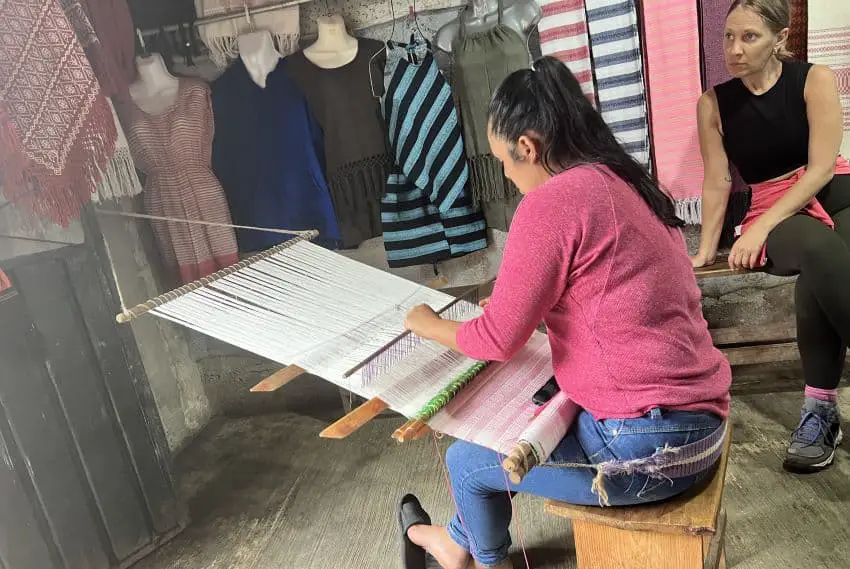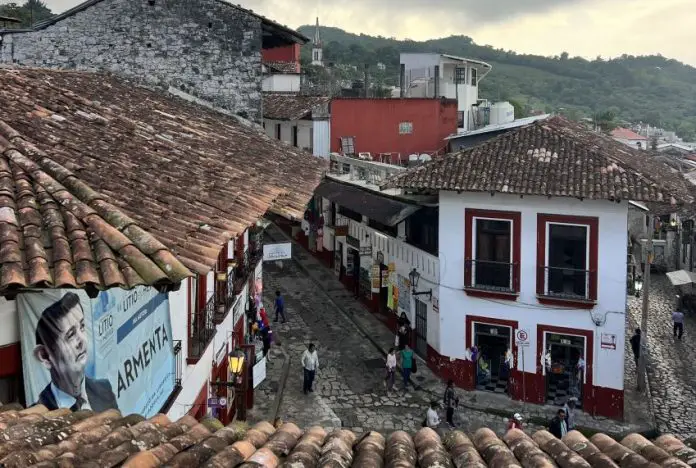Since relocating to Mexico, I, perhaps like many others, have developed an unexpected passion for crafts. It’s impossible not to, with the plethora of stunning “artesanías” the country has to offer. Nowhere is this more obvious than in the town of Cuetzalan, Puebla.
“Crafts” is not nearly adequate enough of a word to do justice to Mexican artesanías. It brings to my mind childish “arts and crafts” or knick-knacks from a fair. In Mexico, artesanías are more akin to exquisite handmade arts — very intentional creations for display or usage, of admirable quality and materials, often using near-ancient methods passed down from generation to generation for centuries. It’s particularly delightful when one encounters talented artisans experimenting with modern designs using traditional production techniques. From region to region, artesanías vary, reflecting the area’s native materials, its style, and traditions.

It was this allure of artesanías and fascination with indigenous culture that drew our trio — Lourdes, Bethany, and myself — to Cuetzalan, though crafts as I had imagined them were not quite what we found there.
We set out from Mexico City on a Thursday morning. I had packed my habitual giant bag of snacks: raisin and walnut baguettes from Rosetta, bananas, dates, dark chocolate and a relatively unappetizing Cliff bar for emergencies. The plan was to drive to Puebla, the halfway point, spend a night and continue onward to Cuetzalan the following morning.
Puebla proved to be a treat. We enjoyed a tourist-free jaunt around the city, browsed antique markets, dined at the delightful Oaxacan restaurant Casa Bacuuza and enjoyed several hours sunning ourselves at the hotel’s rooftop pool. In the morning, we stopped at the glass factory Fábrica de Vidrio la Luz, and after excitedly ogling a Mexican actor we recognized from a Netflix show from behind a rack of margarita glasses, we set off for Cuetzalan.
The roads became winding and misty as we ascended to the city, dotted with cattle, horses, and chickens mingling on the side of the road. About an hour and a half from our destination, we stopped at a small roadside vendor to stock up on some of the crunchiest and most flavorful apples we’d ever tasted.

Two hours, dozens of kilometers of winding roads and 38 songs later, we arrived at our hotel in Cuetzalan. Being the adventurous exploradoras we were, we had opted for an eco-hotel run by indigenous women, which was very much akin to cabins or glamping. In hindsight, other accommodations might be more comfortable for those such as myself, who are averse to the inherent dirt, mosquitoes and the excessive moisture that creeps into such structures. I had romanticized the experience in my mind, but nevertheless the surrounding nature was undeniably lovely.
Having donned our raincoats and with our belongings situated in our cabins, we ventured out into a storm to find a glass of strong mezcal and a cozy restaurant for dinner.
While not number one rainiest spot in the country, Cuetzalan is still one of the rainiest areas in Mexico. Set high up in the Sierra Norte hills in northern Puebla State, the region enjoys a warm and humid climate due to its proximity to the Gulf of Mexico. The rainfall contributes to its lush, jungle-like vegetation and numerous waterfalls. The town itself is a maze of steep, cobblestone streets carefully designed for grip in the perpetual dampness. It’s built along a multitude of sloping boulevards, paths, and streets. As Bethany would later aptly caption an Instagram post accompanying a photo of the town, “Hills, hills, hills.”
Our first evening led us to Taol, an exceptional restaurant efficiently run by what seemed to be an all-woman team. It was a dream, set in a mystical indoor-outdoor space where we watched the rain from a covered garden patio as we sipped our cocktails. We devoured chicken over warm banana bread bathed in mole, an entire fresh grilled fish, queso sizzling over cecina and steaming corn tortillas.

Afterwards, overstuffed and guided by the glow of mezcal in our bellies, we stopped into a very local bar — think Cheers, but most likely someone’s converted living room — to enjoy a glass of the region’s traditional liquor, Yolixpa. Yolixpa, Nahuatl for“medicine of the heart,” is very much like Cuetzalan — a mix of everything. It combines up to twenty to thirty herbs, including hierbabuena (spearmint), fennel, mint, and lemon verbena with a base spirit, usually made of distilled sugarcane. It’s rumored to cure everything from heartache to illness, and it certainly provided a hearty start to our adventure as we made our way back to our lodgings.
Cuetzalan’s “bread and butter,” our guide Ricardo would inform us the next morning, is tourism. Even so, despite being a tourist destination, Cuetzalan has largely escaped commercialization. It’s a study in contrasts: charming yet gritty, nature-filled yet bustling, small-town Mexican rustic crossed with remnants of Spanish colonial architecture. Many of the men wear ranchero-style cowboy hats and leather belts, while the women don colorfully embroidered white huipils. It’s picturesque yet “real.” Live music blasts from quinceañeras set in giant barn-like halls while, in the town square next to the incredibly opulent Parish of St. Francis of Assisi, “Voladores” (flying men) soar and spin, suspended from a high pole. Below them, vendors sell their wares in a market, as families share a meal together in neighboring restaurants. Down the street, at the Iglesia de los Jarritos, a 19th-century monastery surrounded by a gloomy cemetery hosts murmuring lovers seated among the parapets, while cemetery visitors pray at the graves of their deceased loved ones. There is so much going on that it’s almost absurd, but it’s all so fascinating.
On our second day, I was not opposed when Lourdes — a bit of a daredevil and adrenaline junkie — suggested we embark upon a 6-hour tour of some of Cuetzalan’s caves, grottos and waterfalls. The tour would encompass several ziplines hundreds of meters above Cuetzalan’s valleys, a trek through an underground river, and my first experience rappelling, descending 60 meters by rope into the impressive Chichicazapan cave. It was magical.

The next day before departing, we explored Cuetzalan’s famed Sunday market. The region is renowned for its fragrant coffee, which is grown on plantations in the surrounding hills. It’s also celebrated for its textiles, including intricately embroidered blouses and quechquemitls (one-piece shawls) created using traditional techniques like back-strap loom weaving.
As a last stop on our way to Mexico City, chasing a lead from a staff member of our hotel, we passed through the tiny town of San Miguel Tenextatiloyan — nicknamed “the town of clay pots.” The town is rumored to have been producing clay artesanías since pre-hispanic times and it did not disappoint. The handmade clay pieces were a crafts-lover’s dream.
So the next time you find yourself in need of a weekend escape, consider Cuetzalan. It isn’t just a destination: it’s an unforgettable escape filled with authenticity and adventure that will throw your senses into a tizzy. Just remember to pack your sense of humor and an umbrella.
Monica Belot is a writer, researcher, strategist and adjunct professor at Parsons School of Design in New York City, where she teaches in the Strategic Design & Management Program. Splitting her time between NYC and Mexico City, where she resides with her naughty silver labrador puppy Atlas, Monica writes about topics spanning everything from the human experience to travel and design research. Follow her varied scribbles on Medium at https://medium.com/@monicabelot.
